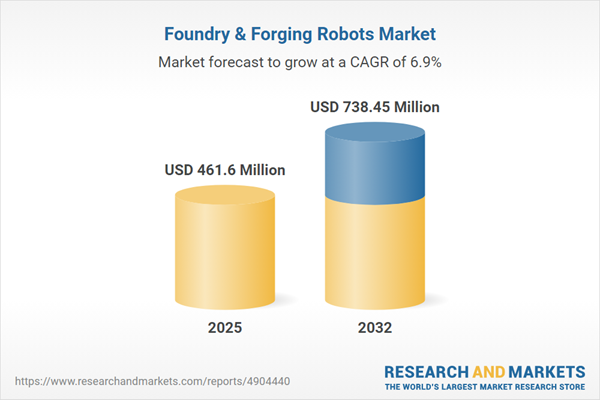Speak directly to the analyst to clarify any post sales queries you may have.
The Foundry & Forging Robots Market is undergoing significant transformation, guided by strategic innovation and strengthened by advanced automation technologies. As senior leaders seek operational resilience and rapid ROI, robotics now offers the foundry and forging sectors actionable pathways to heightened productivity, quality assurance, and future-ready manufacturing ecosystems.
Market Snapshot: Foundry & Forging Robots Market
The Foundry & Forging Robots Market grew from USD 434.45 million in 2024 to USD 461.60 million in 2025. It is expected to continue growing at a CAGR of 6.85%, reaching USD 738.45 million by 2032. Market momentum is driven by advanced automation, integration of robotics across diverse manufacturing settings, and a sustained focus on efficiency and flexibility. This sector’s expansion presents critical opportunities for organizations aiming to optimize labor, maintain quality standards, and respond effectively to shifting industrial dynamics.
Scope & Segmentation
This report provides in-depth analysis of market segmentation and technological adoption, equipping decision-makers with a clear picture of value chains and innovation leaders.
- Type: Electric Drive Robots, Hydraulic Robots
- Component: Hardware (Controllers, Robotic Arms, Sensors & Vision Systems), Services (Installation Services, Maintenance & Support, Training Services), Software
- Robot Type: Articulated Robots, Cartesian Robots, Collaborative Robots, Delta Robots, Dual-Arm Robots, SCARA Robots
- Application: Casting Extraction, Core Assembly, Deburring, Grinding & Polishing, Ladling, Mold Handling
- End-Use Industry: Aerospace & Defense, Automotive, Consumer Goods, Electronics, Healthcare, Manufacturing & Heavy Industries
- Geography: Americas (North America: United States, Canada, Mexico; Latin America: Brazil, Argentina, Chile, Colombia, Peru); Europe, Middle East & Africa (Europe: United Kingdom, Germany, France, Russia, Italy, Spain, Netherlands, Sweden, Poland, Switzerland; Middle East: United Arab Emirates, Saudi Arabia, Qatar, Turkey, Israel; Africa: South Africa, Nigeria, Egypt, Kenya); Asia-Pacific (China, India, Japan, Australia, South Korea, Indonesia, Thailand, Malaysia, Singapore, Taiwan)
- Key Companies: ABB Ltd., Acieta, LLC., BGR NEO Ltd., Borunte Robot Co., Ltd., Bosch Rexroth AG, Comau S.p.A., Difacto Robotics and Automation Pvt. Ltd., Doosan Robotics Inc., ENGEL AUSTRIA GmbH, FANUC CORPORATION, Kawasaki Heavy Industries, Ltd., KUKA AG, Mitsubishi Electric Corporation, Nachi-Fujikoshi Corp., Seiko Epson Corporation, Siemens AG, Sintokogio, Ltd., SIR Spa, Stäubli International AG., TECHMAN ROBOT INC., Universal Robots A/S by Teradyne, Yamaha Motor Co., Ltd., YASKAWA Electric Corporation
Key Takeaways for Senior Decision-Makers
- Robotic transformation is delivering sustained process consistency and is strengthening overall production resilience across foundry and forging plants.
- Industry 4.0 principles are being adopted, with digital twin simulations and modular cell design now essential for validating process changes and supporting rapid reconfiguration on the shop floor.
- Collaborative robots are gaining relevance, enabling human-robot synergy for labor-intensive yet precision-driven tasks such as mold loading, extraction, and finishing.
- Major suppliers and system integrators are differentiating through end-to-end service models, lifecycle management, and strategic partnerships for embedded innovation.
- Environmental mandates are driving adoption of energy-recovery systems and efficient hydraulic circuits, aligning operational goals with sustainability policies.
- Market expansion in Asia-Pacific is facilitated by smart manufacturing incentives and technology adaptation, while Europe and the Americas focus on high-precision robotics for niche applications and compliance with evolving trade requirements.
Tariff Impact & Supply Chain Agility
Recently imposed American trade levies on metals and industrial components have increased material and component costs, spurring industry leaders to reexamine sourcing strategies. Responses include localization of assembly, diversification of suppliers, and investment in traceability solutions for real-time compliance. Strategic partnerships with domestic foundries and substitution of alternative alloys are further supporting cost management and supply continuity.
Methodology & Data Sources
The report is built on comprehensive primary interviews with plant managers, engineers, and system integrators, bolstered by secondary research from industry publications, technical standards, and proprietary databases. Insights are validated through case studies and expert feedback, ensuring a well-rounded perspective tailored to real-world conditions in the foundry and forging robots sector.
Why This Report Matters
- Enables confident technology selection and implementation by providing a clear view of segment performance and regional trends.
- Gives actionable guidance on supply chain risk management and regulatory compliance for sustainable operational excellence.
- Supports C-level strategy with focused insights on innovation, workforce development, and market positioning in the global foundry and forging robotics ecosystem.
Conclusion
The foundry and forging robots market is advancing rapidly, with leaders leveraging intelligent automation for enhanced productivity and resilience. Strategic adoption and investment in robotics now serve as critical drivers for sustainable growth and long-term competitiveness.
Additional Product Information:
- Purchase of this report includes 1 year online access with quarterly updates.
- This report can be updated on request. Please contact our Customer Experience team using the Ask a Question widget on our website.
Table of Contents
3. Executive Summary
4. Market Overview
7. Cumulative Impact of Artificial Intelligence 2025
Companies Mentioned
The companies profiled in this Foundry & Forging Robots market report include:- ABB Ltd.
- Acieta, LLC.
- BGR NEO Ltd.
- Borunte Robot Co., Ltd.
- Bosch Rexroth AG
- Comau S.p.A.
- Difacto Robotics and Automation Pvt. Ltd.
- Doosan Robotics Inc.
- ENGEL AUSTRIA GmbH
- FANUC CORPORATION
- Kawasaki Heavy Industries, Ltd.
- KUKA AG
- Mitsubishi Electric Corporation
- Nachi-Fujikoshi Corp.
- Seiko Epson Corporation
- Siemens AG
- Sintokogio, Ltd.
- SIR Spa
- Stäubli International AG.
- TECHMAN ROBOT INC.
- Universal Robots A/S by Teradyne
- Yamaha Motor Co., Ltd.
- YASKAWA Electric Corporation
Table Information
| Report Attribute | Details |
|---|---|
| No. of Pages | 180 |
| Published | November 2025 |
| Forecast Period | 2025 - 2032 |
| Estimated Market Value ( USD | $ 461.6 Million |
| Forecasted Market Value ( USD | $ 738.45 Million |
| Compound Annual Growth Rate | 6.8% |
| Regions Covered | Global |
| No. of Companies Mentioned | 24 |









